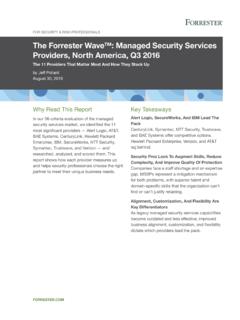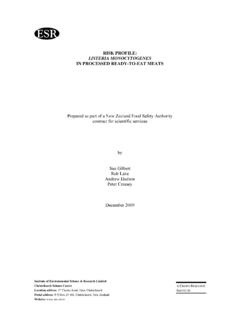Transcription of AN EXAMINATION OF POLICE CANINE USE OF …
1 AN EXAMINATION OF POLICE CANINE USE OF FORCE. IN THE STATE OF FLORIDA. By CHARLES MESLOH. AN EXAMINATION OF POLICE CANINE USE OF FORCE. IN THE STATE OF FLORIDA. by CHARLES MESLOH. Florida Gulf Coast University, 2000. University of Florida, 1987. A dissertation submitted in partial fulfillment of the requirements for the degree of Doctor of Philosophy in the Department of Public Affairs in the College of Health and Public Affairs at the University of Central Florida Orlando, Florida Summer Term 2003. 2003 Charles Mesloh ii ABSTRACT. The use of force with POLICE dogs has caught the attention of both the media and the federal government, specifically the Department of Justice (DOJ). Recently, the Department of Justice has begun recommending sweeping changes for agencies that are under review for civil rights violations. The recommendation of interest to this study is the paradigmatic shift from bite and hold to bark and hold in CANINE apprehension methods.
2 As there is no prior literature to base this decision upon, the question remains, will this reduce the number of suspect bitten by POLICE dogs? This work attempts to answer this question by asking CANINE handlers to reveal their bite ratios through a traditional method and through an innovative matrix (Bite Ratio Data Collector), which then become the force measurement. Individual, organizational, situational and iii training variables are added to the linear regression model to identify correlates of CANINE force. The survey was distributed to 334 CANINE handlers (comprising a census) in the State of Florida. Of those, 181 (52%) responded providing not only demographic information on themselves and their agencies but for their CANINE partners as well. The results from Chapter 4 denote a number of findings. First, measurement differences were obvious between traditional reporting and the Bite Ratio Data Collector. Simply asking handlers to provide bite ratios tends to underestimate the actual amount of CANINE force.
3 Second, handlers with bark and hold trained canines reported higher bite ratios than handlers with bite and hold trained dogs. Finally, additional factors such as dog breed, Shutzhund training, the number of CANINE calls, and whether or not the dog was sexually intact were all significant correlates of CANINE force in the final model. iv This dissertation is dedicated to my wife, Jennifer, my son Perry, and my parents without whose love and patience I could never have come so far. This dissertation is also dedicated to my CANINE partners Axel, Xina, Rommel and Caya who not only protected my life on numerous occasions but also provided a special insight into this type of research. v ACKNOWLEDGMENTS. There have been so many people who have been instrumental in the completion of this work. I am indebted to the expertise and direction that I received from my committee members, Dr. Bernard McCarthy, Dr. Paul Maiden, and Dr. Ross Wolf. I would like to express special gratitude to my committee Chair, Dr.
4 Stephen Holmes for his encouragement, patience, and commitment to purpose throughout this project. Appreciation is extended to Dr Eileen Abel and Margaret Mlachak for their efforts throughout the program and the special things that they did to make life a little easier and to Chief Richard Turkiewicz for allowing me to join his family' at the UCF POLICE Department. Special appreciation is extended to Mark Henych, who was not only my colleague and co-worker, but also truly a good friend who kept me focused and on track. vi TABLE OF CONTENTS. LIST OF FIGURES x LIST OF TABLES xi LIST OF ABBREVIATIONS xiii CHAPTER 1: Introduction 14. Statement of the Problem 14. Historical Review 15. Use of Canines in Modern POLICE Operations 18. Incidence and Prevalence of POLICE CANINE Usage 20. CANINE Oversight and Training 21. The Legal and Practical Importance of this Research 24. The Present Study 28. Summary and Conclusions 31. CHAPTER 2: LITERATURE REVIEW 34.
5 Introduction 34. Efficiency Through Advances in Technology 36. Historical Review 37. The Use of Canines in POLICE Operations 40. Building Searches 41. Area Searches 42. Tracking 43. Types of Agencies Using POLICE Canines 45. How Canines are Trained 48. Drives 50. Apprehension Methods and Models 54. Bite and Hold 55. Bark and Hold 57. Use of Force 59. Discretion 61. Less Lethal Force Options 63. Canines as a Forceful Intervention 69. Case Law 73. Bite Ratios and Computational Components 79. Summary 80. vii CHAPTER 3: METHODS 83. Introduction 83. Problem Statement 83. Hypothesis Testing 84. Methodology 86. The Sample 90. The Survey 94. Focus Group and Pilot Test 95. Distribution of the Instrument 96. Study Data 97. Dependent Variable 98. Bite Ratios 98. Independent Variables 104. Apprehension Method 104. Training Methods 105. Policy Guidelines 109. Individual Officer Demographics 111. Organizational Variables 113. CANINE Training 114. Agency Type and Productivity 117.
6 CANINE Demographics 119. Conclusion 124. CHAPTER 4: FINDINGS 126. Introduction 126. Presentation of the Findings 127. Population and Demographic Characteristics 129. Officer Demographics 130. Demographics of POLICE Dogs in Service 133. Organizational Demographics 135. Training Demographics 137. Situational Factors 140. Significance Testing 142. Research Question 1 143. Research Question 2 146. Research Question 3 149. Model One: Handler Demographics 150. Model Two: Organizational Variables 152. Model Three: Situational Factors 153. Model Four: Training Variables 155. Final Model: Combined Factors 159. Self-Report Data 160. BRDC Data 161. viii Summary 164. CHAPTER 5: CONCLUSION 166. Statement of the Problem 166. Summary and Discussion of the Findings 168. Research Question 1 168. Research Question 2 171. Research Question 3 173. Methodological Limitations 177. Conclusion and Recommendations 178. Replication 178. Future Research 180. APPENDIX A: KEY TERMS 181.
7 APPENDIX B: SURVEY INSTRUMENT 184. APPENDIX C: META-ANALYSIS OF CANINE LITERATURE 194. REFERENCES 196. ix LIST OF FIGURES. Figure 1 Bite Ratio Model 98. Figure 2 Bite Ratio Padded 101. x LIST OF TABLES. Table 1 Early POLICE Technology Timeline 36. Table 2 Task of Canines in Local Operations 47. Table 3 Less Lethal Technology 65. Table 4 CANINE Case Law 76. Table 5 Bite Ratio Data Collector 103. Table 6 Meta Analysis of Officer Misconduct 112. Table 7 Officer Demographics 132. Table 8 CANINE Demographics 134. Table 9 Organizational Demographics 136. Table 10 Training Characteristics 138. Table 11 Situational Factors 141. Table 12 T-Test Between Bite Ratio Collectors 144. Table 13 T-Test Between Apprehension Methods 147. Table 14 Regression of Bite Ratios by Officer Demographics 151. Table 15 Regression of Bite Ratios by Organizational Variables 152. Table 16 Regression of Bite Ratios by xi Situational Factors 154. Table 17 Regression of Bite Ratios by Training Factors 156.
8 Table 18 Regression of Bite Ratios by Combined Factors 160. Table 19 Meta Analysis of CANINE Research 194. xii LIST OF ABBREVIATIONS. Bite Ratio Data Collector BRDC. Department of Justice DOJ. Florida Department of Law Enforcement FDLE. International Association of Chiefs of POLICE IACP. Los Angeles POLICE Department LAPD. National POLICE CANINE Association NPCA. National Institute of Justice NIJ. North American POLICE Work Dog Association NAPWDA. United States Air Force USAF. United States Department of Agriculture USDA. United States POLICE CANINE Association USPCA. xiii CHAPTER 1: INTRODUCTION. Law enforcement agencies frequently use specially trained dogs for a variety of important purposes to aid in the detection and deterrence of crime. The primary reason is that dogs are a cost effective means for crime control. These dogs possess skills and abilities that frequently exceed that of existing technology. Their use in the past has provided law enforcement with a valuable tool, which if used properly, can improve both the efficiency and effectiveness of policing, all the while serving as an important public relations tool.
9 However, little empirical research has been conducted regarding POLICE dog deployment as a use of force. Statement of the Problem This study seeks to: (1) examine the effect of the paradigmatic shift to the bark and hold training method 14. of patrol dogs in the state of Florida who were identified by the Florida Department of Law Enforcement; (2) develop a new methodology for collecting bite ratio data; (3). determine to what extent bite ratios differ based upon selected demographic and training variables. Historical Review Dogs have shared their lives with mankind for the better part of the last 20,000 years. Some research indicates that the first domesticated canines were wolves used for the purpose of assisting humans hunt for food (Lilly &. Puckett, 1997). This research is supported by a recent archeological discovery of a 12,000-year-old skeleton found cradling the body of a pup (Lange, 2002). Not only have canines helped humans hunt for food and provided them companionship, but they have also been used to provide for their master's protection.
10 In fact, since early times, canines have been trained to fight and die on command (Jennings, 1998; Lilly & Puckett, 1997). The extant literature on the use canines in warfare 15. dates as far back as 700 (Chapman, 1990). Evidence of their military contributions can be found in every conflict since antiquity (Lilly & Puckett, 1997; Murray, 1984). During World War II, it is estimated that 250,000 dogs were used by the participants of both sides in a variety of functions (Marders, 1960; United States Air Force, 1973). One military analysis credits scout dogs with saving over 2,000 American lives during the Vietnam conflict (Murray, 1984). Canines have not just been used by the state for war. They have also been used to protect the peace and maintain domestic tranquility. In fact, the first reported use of canines to supplement law enforcement dates back to the 1300's in St. Marlo, France (Lilly & Puckett, 1997). However, it wasn't until 1889, that the first training school for POLICE canines was established in Ghent, Belgium (Thurston, 1999; Jennings, 1998;Chapman, 1990; O'Block, Doeren, & True, 1979).





